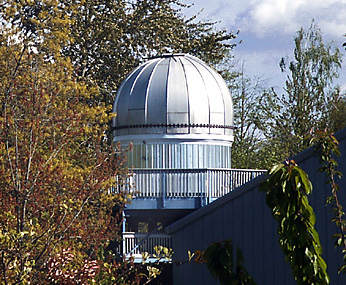

Here's one of the places we OSP types hang out at during the "Off" season from OSP. We're at about 500 feet elevation, right on the campus of Clackamas Community College (CCC) in Oregon City. Lots and lots of city lights are in every direction. No one would dare to allege that there are ever dark skies here, but it looks and feels like an astronomical place and fills the void. The big presence of Haggart's 24 inch scope also makes it feel like a real observatory. Finally, the Observatory draws many, many of the public, and it is our pleasure to try to inspire them. Personally, for me, I love the way Haggart feels a bit like being on a mountaintop, as it is built atop a 45 foot high tower, which seeks to elevate it above the many tall trees in the vicinity. The Rose City Astronomers has an agreement with the college to do most of the maintainance, but recent safety review has apparently limited public openings of the observatory.... See section at page bottom which will detail how cloudy/rainy it is in Oregon City vs. other locations in the Western U.S.
For more info go to the Clackamas Community College website and use their search engine (clakamas.edu), or call 503-594-6044.
| Location | # of clear days per year * | # of cloudy days per year | # of days with .01 inch of rain or more** |
| Portland Area | 68 days | 222 days | 151 days |
| Olympia, WA | 52 days | 229 days | 162 days |
| Pendleton, OR | 101 days | 173 days | 98 days |
| Burns, OR | 123 days | 151 days | 92 days |
| Medford, OR | 118 days | 169 days | 101 days |
| Reno, Nevada | 158 days | 114 days | 50 days |
| Sacramento, California | 189 days | 101 days | 58 days |
| Las Vegas, Nevada | 210 days | 73 days | 26 days |
* The definition of "Clear" as measured by the Weather Service is set against a scale of 10, and any day with 0 to 3 cloudiness is rated as "clear." Secondly, of note for Astronomers is the fact that cloudiness is a daytime-only value, and thus does NOT deal with the fact that quite often a sunny Portland afternoon is followed by the formation of "low clouds" within a few hours of sunset, thus nixing out any astronomy!
** Note that .01" inch of rain does NOT capture days where a "Trace" falls, and it doesn't account for the "worry" value of days where clouds and/or the forecast threaten rain, but it doesn't end up happening. If I were to take a guesstimate of such days, I would guess that Portland has over 180 days a year with at least a trace of rain, and/or where rain is in the forecast, and/or the clouds worry folks about the wisdom of such outdoor things as astronomy, outdoor weddings, picnics, etc..... a final note about rain is to note that the chart above does not take into account the average relative humidity of the various locations, but humidity does have an important bearing in this way: in areas where humidity is typically high like in Portland, even a little rain falling wets things down and then they stay that way for many hours or even days, WHEREAS in the typically low humidity areas such as Medford in the summer, or Las Vegas year-round, rain evaporates quickly and objects seldom stay wet for long-- if your astronomy equipment gets a little dew in Portland, it will be difficult but important to dry it off because mold and fungus can form, whereas in drier regions you can usually count on any moisture to just vanish of its own accord.